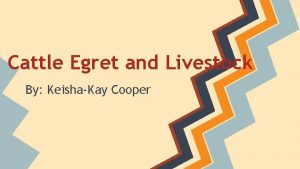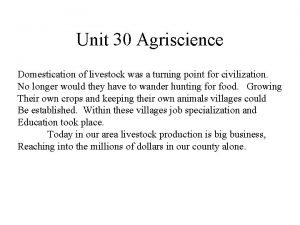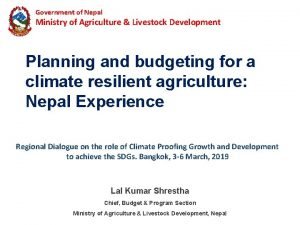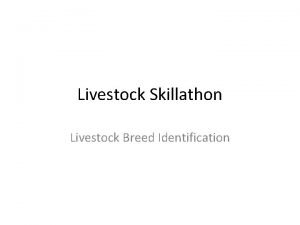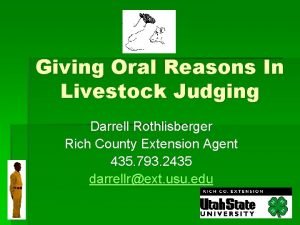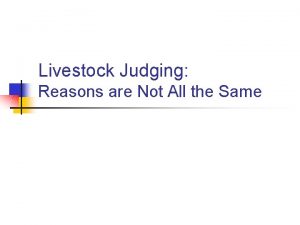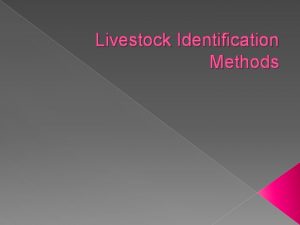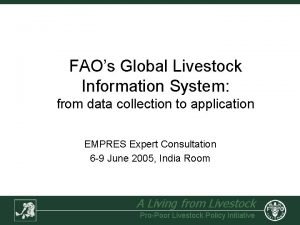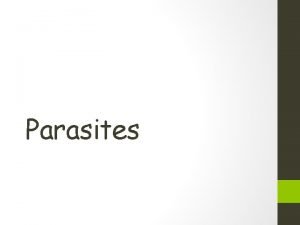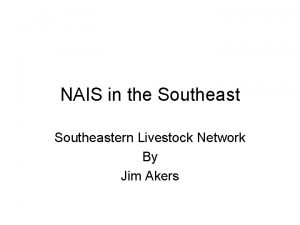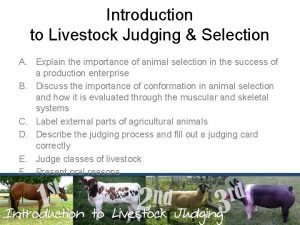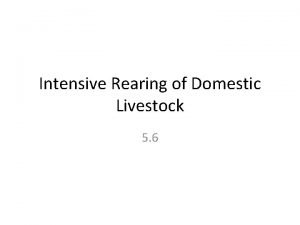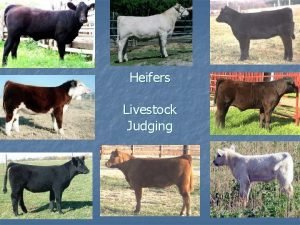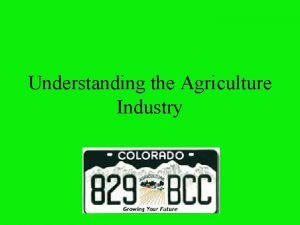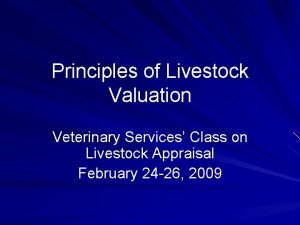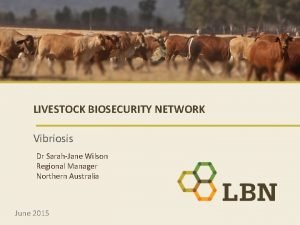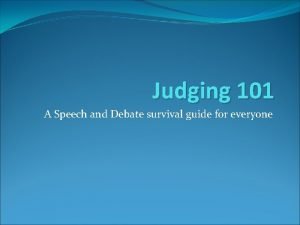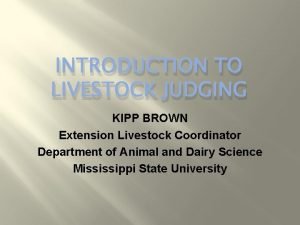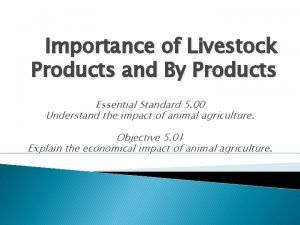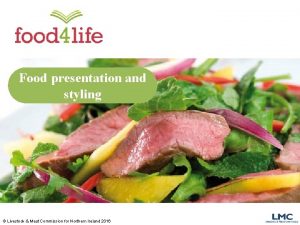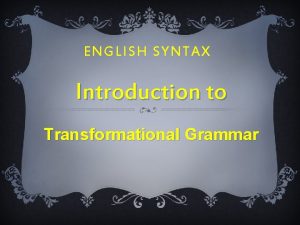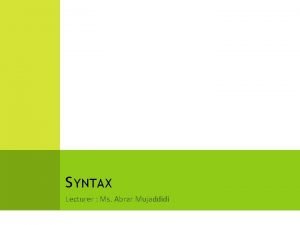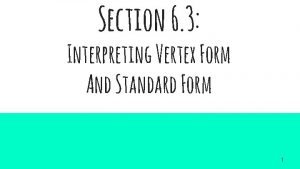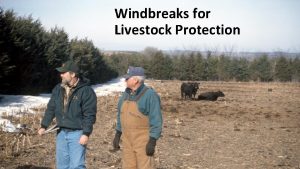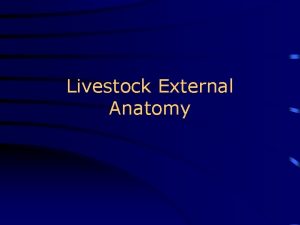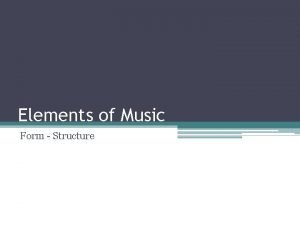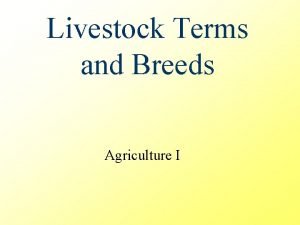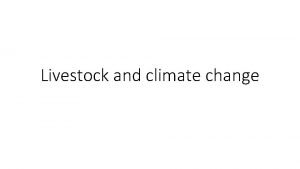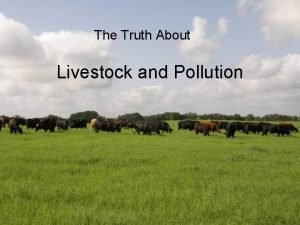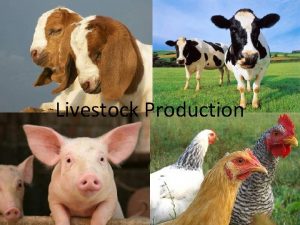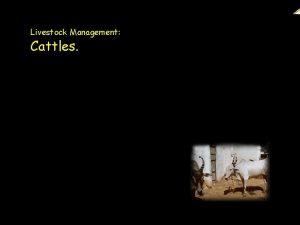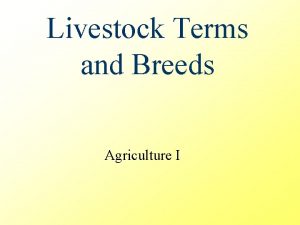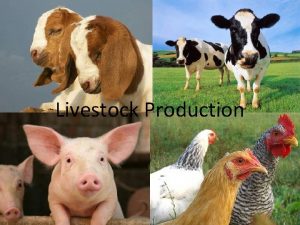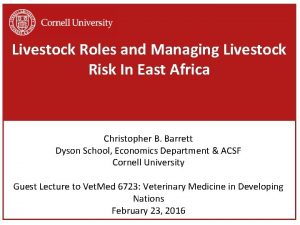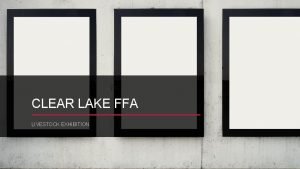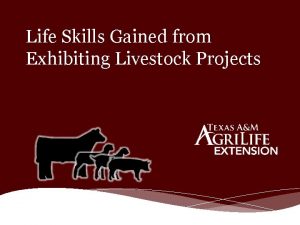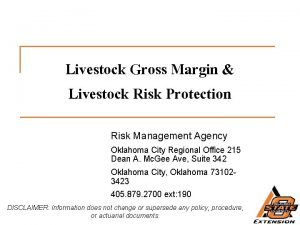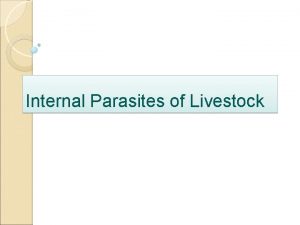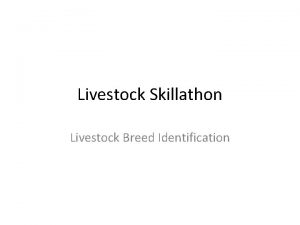Anatomy of Livestock Anatomy Form and structure of


































- Slides: 34

Anatomy of Livestock

Anatomy • Form and structure of the body and its parts • What things look like and where they are located

System of the body Organs in the body Job or function Skeletal bones Protects vital organs Muscular Muscle(meat) Support and move body Sensory Eyes, ears, nose, skin Sense and detect things outside the body Nervous Brain, nerves spinal cord Pass messages around the body, control the body Circulatory Heart, blood vessels The blood carries substances around the body Respiratory Muzzle, windpipe, lungs Breathing Digestive Stomach, liver, intestine, pancreas Digest and absorb feed Urinary Kidneys, bladder Gets rid of poisons and waste Reproductive Testes, penis, ovaries, uterus, To produce and feed young vagina, vulva, udder

Directions

Body Cavities • Ventral body cavity – Contains most of the soft organs; divided by thin diaphragm • Thoracic cavity- heart, lung, esophagus, blood vessels • Abdominal cavity- digestive tract • Pelvic cavity- urinary organs, reproductive organs • Dorsal body cavity – Contains the brain and spinal cord • Cranial cavity- brain • Spinal cavity- spinal cord

Cranial Cavity Spinal Cavity Dorsal Cavity Ventral Cavity Thoracic Cavity Diaphragm Abdominal Cavity

Different Systems • • • Skeletal system Muscular system Sensory system Nervous system Circulatory system Respiratory system Digestive system Urinary system Reproductive system

Skeletal System • Bony tissue • Framework from the animals body • The size and shape of animals is determined by the skeleton

The Skeletal System • Functions – Protection for vital organs – Helps keep organs properly arranged in the body

Skeletal System • Compact bone – Honeycombed – Hard part of the skeleton – Bony tissue • Calcium • Phosphorus

Skeletal System • Cartilage – Flexible at the ends of bones – Flexible material that lubricates the joints and cushion shocks

Muscular System • The largest system in the body, making up about 45% of the body weight of hogs, cattle, and chickens • Lean meat of animals

Muscular System • Important for movement – Locomotion – Circulation – Digestion – Breathing

Muscular System • Two types of muscles – Voluntary: controlled by the thinking part of the brain – Involuntary: automatically controlled by a lower part of the brain

Nervous System • Provided animals with ability to react or adjust to different situations • Helps with physical activity • Provides pathways for all the senses • Central Nervous System has the brain and spinal cord • Peripheral Nervous System has somatic nerves which is muscles and skin and autonomic nerves which is the visceral organs


Sensory • The brain also controls the senses. Different organs are: – The eyes for sight – The ears for hearing – The nose for smell – The tongue for taste – The skin for touch

Circulatory • Moves digested food, oxygen, wastes, and other materials around the body. Systematic circulation is the movement of blood throughout the body

Circulatory System • Blood-liquid in the circulatory system – Plasma-90% water – Solid materials- glucose, vitamins, minerals, and amino acids (proteins)

Circulatory System • Solids in the blood include: – Red blood cells • Contain hemoglobin • Made in the bone marrow – White blood cells • Help fight off disease • Pus that forms at wounds is a collection of white blood cells – Platelets • Essential for blood to clot

Circulatory System • System parts – Heart: Pump that sends blood throughout the system – Arteries: Vessels that carry blood from the heart – Capillaries: Small branches from the arteries that carry blood to the cells – Veins: Carry blood back to the heart

Respiratory System • Moves gases to and from the circulatory system • Internal respiration – Exchange of gases between the cells and the blood within the body • External respiration – Exchanges of gases in the lungs between the blood and the atmosphere

Respiratory System • Parts of the Respiratory system – Nostrils: openings near the mouth through which gases enter and leave the body – Pharynx: connects the nose area with the mouth area – Larynx: often called voice box – Trachea: known as the windpipe; connects the pharynx with the lungs – Lungs: where gas is exchanged between the atmosphere and the blood

Respiratory System • Breathing process involves air entering and leaving the lungs – Inspiration: process of taking air into the lungs – Expiration: Process of moving air out of the lungs

Digestive System • Consists of the teeth, mouth, esophagus, stomach, intestine, liver, pancreas, and rectum • Begins in mouth where food is broken down into smaller pieces. In stomach it is mixed with juices to form soft paste. Then passes through intestine where bile from liver and juices from pancreas are added. Waste collects in rectum and passes out through anus (or cloaca in birds)

Digestive System • Different livestock species have different digestive systems • Ruminants have four compartments to stomach – Rumen, reticulum, omasum, abomasum • Poultry have a crop, proventriculus and ventriculus

Digestive System • Monogastric – Simple stomach – One compartment • • • Pigs Horse Dog Cat Birds

Endocrine System • The endocrine system functions are – Controls growth – Reproductive functions • Heat • Lactation • birth – Shape of the animal – Feed efficiency

Urinary System • Main organ are the two kidneys, which lie against the backbone and bladder • Waste materials and water are taken out of the blood in kidneys • Forms urine which is then collects in bladder and passes out of the body

Urinary System • Kidney’s are shaped differently for different livestock – Lobulated • Cattle • Chicken – Heart shaped • Horse – Bean shaped • Pigs • Sheep

Reproductive System • Two different reproductive systems: • Female produces eggs from ovaries and gives birth • Male produces sperm from testis and fertilizes the egg

Female Reproductive System • Consists of two ovaries, one on each side of abdomen. • Ovaries produce eggs which pass into the uterus. • Below the uterus is the vagina which opens to the outside surrounded by vulva.

Male Reproductive System • Male reproductive organs, the testicles, lie in the scrotum behind the penis • Testicles produce the sperm in the semen • In the bird the testicles are inside the body

References • www. lsu. edu/lata/L 3 -1. doc • http: //www. fao. org/docrep/t 0690 e 04. htm
 Cattle egrets and livestock
Cattle egrets and livestock Livestock breed identification swine - vocabulary
Livestock breed identification swine - vocabulary Ministry of agriculture and livestock development nepal
Ministry of agriculture and livestock development nepal Livestock breed identification swine - assessment
Livestock breed identification swine - assessment Livestock judging oral reasons
Livestock judging oral reasons Livestock judging reasons
Livestock judging reasons Livestock risk management brokers near me
Livestock risk management brokers near me Livestock classification chart
Livestock classification chart Livestock identification methods
Livestock identification methods Livestock information system
Livestock information system Parasites of livestock - vocabulary
Parasites of livestock - vocabulary Livestock network
Livestock network Livestock judging card
Livestock judging card Domestic livestock
Domestic livestock Beef cattle judging practice
Beef cattle judging practice Colorado livestock
Colorado livestock Livestock valuation methods
Livestock valuation methods Livestock biosecurity network
Livestock biosecurity network Livestock judging 101
Livestock judging 101 Livestock judging terminology
Livestock judging terminology Livestock breed identification swine - vocabulary
Livestock breed identification swine - vocabulary Food presentation is important
Food presentation is important Present continuous affirmative sentences
Present continuous affirmative sentences Imperfect flowers examples
Imperfect flowers examples Structural ambiguity
Structural ambiguity Surface and deep structure
Surface and deep structure Surface structure and deep structure
Surface structure and deep structure Queue is a static data structure
Queue is a static data structure Deep surface structure
Deep surface structure Poem on exams
Poem on exams Descriptive device
Descriptive device A hair’s form and structure is known as what?
A hair’s form and structure is known as what? My last duchess jealousy quotes
My last duchess jealousy quotes Attenuation constant formula
Attenuation constant formula Quadratic function
Quadratic function
